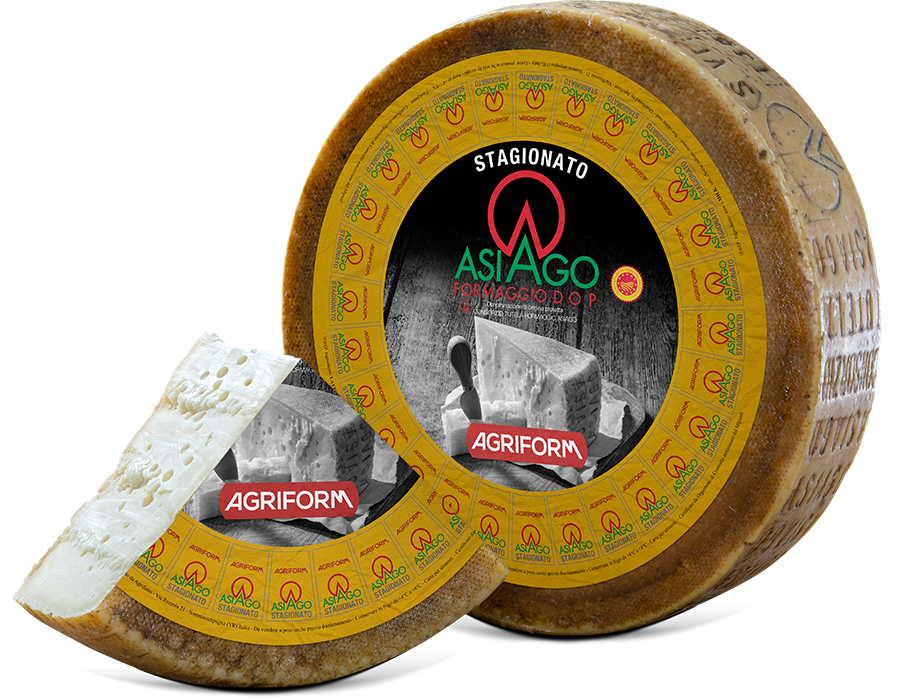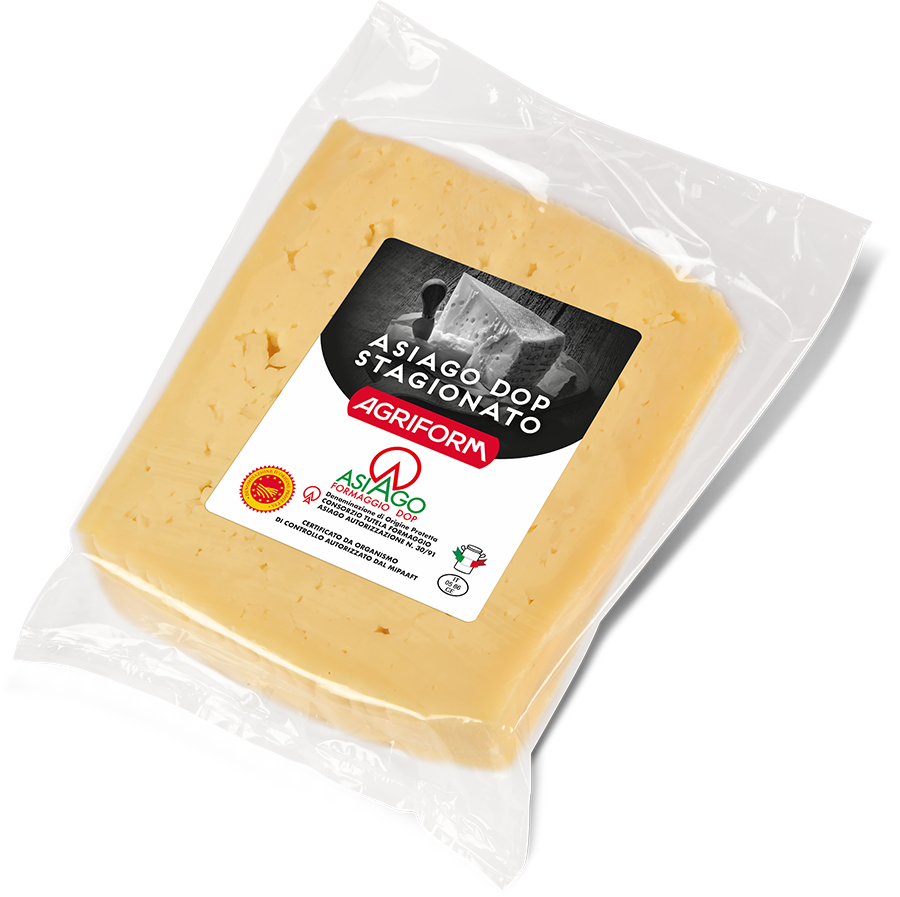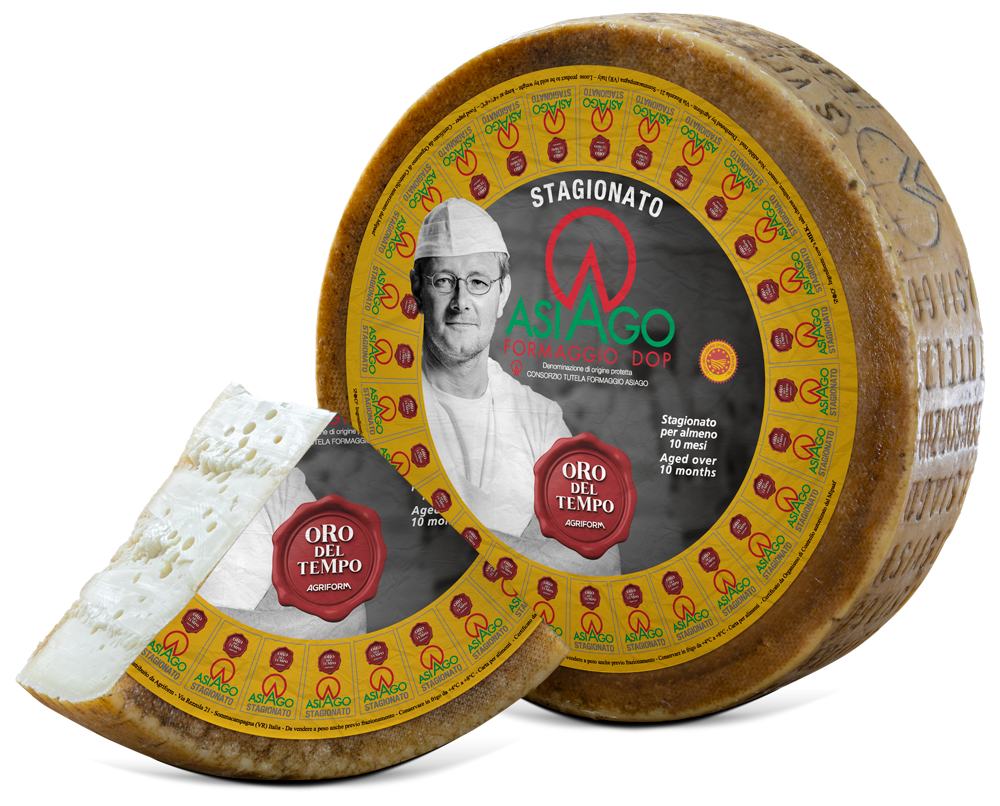
Asiago Stagionato wheels
Asiago Stagionato whole wheels are perfect for Horeca.
Average weight: approx. 9 kg
Dimensions: diameter 30/36 cm and height 9/12 cm
Average weight: approx. 9 kg
Dimensions: diameter 30/36 cm and height 9/12 cm

Vacuum packed Asiago Stagionato
Vacuum packagings allow the longest durability to Asiago Stagionato’s wedges. The total absence of oxygen allows the product to be stored up to 6 months from the packaging date.
Available in the classic ¼ wheel Horeca format, and in 250g wedges for retail.
Available in the classic ¼ wheel Horeca format, and in 250g wedges for retail.

Asiago Stagionato with thermoformed packaging
Asiago Stagionato with thermoformed packaging
The thermoformed package can be gas-flushed (hard tray with open & close film and shelf life up to 4 months) or vacuum packed (flexible easy-open package and shelf life up to 6 months).
The thermoformed package can be gas-flushed (hard tray with open & close film and shelf life up to 4 months) or vacuum packed (flexible easy-open package and shelf life up to 6 months).

Asiago Stagionato in protected atmosphere
Wrapping Matured Asiago under protective atmosphere (food level carbon dioxide and nitrogen) allows to bring to table a cheese slice as if it was just cut. Proposed portion weights span from 250g to ¼ of wheel.

Asiago Stagionato Oro del Tempo
Matured for a minimum of 10 months
Asiago Stagionato PDO
It's a hard, semi-cooked, semi-fat cheese typical of the Asiago Alpine plateau.
It has a smooth, regular rind; it has a compact and granular straw colored paste with a few small or medium size holes.
Depending on the different agings, it is characterized by either a sweeter taste (Mezzano) or by a more intense and fragrant taste (Vecchio).
It has a smooth, regular rind; it has a compact and granular straw colored paste with a few small or medium size holes.
Depending on the different agings, it is characterized by either a sweeter taste (Mezzano) or by a more intense and fragrant taste (Vecchio).

Asiago Stagionato wheels
Asiago Stagionato whole wheels are perfect for Horeca.
Average weight: approx. 9 kg
Dimensions: diameter 30/36 cm and height 9/12 cm
Average weight: approx. 9 kg
Dimensions: diameter 30/36 cm and height 9/12 cm

Vacuum packed Asiago Stagionato
Vacuum packagings allow the longest durability to Asiago Stagionato’s wedges. The total absence of oxygen allows the product to be stored up to 6 months from the packaging date.
Available in the classic ¼ wheel Horeca format, and in 250g wedges for retail.
Available in the classic ¼ wheel Horeca format, and in 250g wedges for retail.

Asiago Stagionato with thermoformed packaging
Asiago Stagionato with thermoformed packaging
The thermoformed package can be gas-flushed (hard tray with open & close film and shelf life up to 4 months) or vacuum packed (flexible easy-open package and shelf life up to 6 months).
The thermoformed package can be gas-flushed (hard tray with open & close film and shelf life up to 4 months) or vacuum packed (flexible easy-open package and shelf life up to 6 months).

Asiago Stagionato in protected atmosphere
Wrapping Matured Asiago under protective atmosphere (food level carbon dioxide and nitrogen) allows to bring to table a cheese slice as if it was just cut. Proposed portion weights span from 250g to ¼ of wheel.

Asiago Stagionato Oro del Tempo
Matured for a minimum of 10 months
PDO
Protected Denomination of Origin
DETAILS:
• Average weight of the wheel: 9 Kg
• Diameter: 30-36 cm
• Height: 9-12 cm
• Ingredients: milk, salt, bacterial culture, rennet. Rind not edible.
AGEING:
• Young: from 2 to 4 months
• Mezzano: from 4 to 10 months
• Oro del Tempo: over 10 months
NUTRITION FACTS (FOR 100G):
• Energy: 1730 kJ / 417 kcal
• Fat: 34g
of which satures: 24g
• Carbohydrate: 0g
of which sugars: 0g
• Protein: 27g
• Salt: 2,1g
Protected Denomination of Origin
DETAILS:
• Average weight of the wheel: 9 Kg
• Diameter: 30-36 cm
• Height: 9-12 cm
• Ingredients: milk, salt, bacterial culture, rennet. Rind not edible.
AGEING:
• Young: from 2 to 4 months
• Mezzano: from 4 to 10 months
• Oro del Tempo: over 10 months
NUTRITION FACTS (FOR 100G):
• Energy: 1730 kJ / 417 kcal
• Fat: 34g
of which satures: 24g
• Carbohydrate: 0g
of which sugars: 0g
• Protein: 27g
• Salt: 2,1g
It is obtained from the transformation of cow’s milk from one or two milkings. After it has been collected and before its made into cheese, the milk undergoes partial skimming by means of separation and is then cooked at a later time. Mezzano is obtained after at least four months of aging; the maturation process can be prolonged up to twelve months and beyond to obtain the highly prized Vecchio cheese, distinguished by the ORO DEL TEMPO brand.
Matured Asiago, also called “d’allevo”, has a long history in the Asiago plateau which for centuries allowed the local population to live off the land and large herds of sheep.
This is the enchanting and fertile location where this delicious cheese was created from goat’s milk in the year 1000, which today is still called “pegorin” in the Vicenzan dialect.
Documents from back then showed that this cheese had become so well-known that the inhabitants from the seven communities used to pay duties and fees in the form of cheese to the rulers of Padova. They even said that in the thirteen century, Ezzelino III da Romano used to select the best form of the year to send to his father-in-law’s table, Emperor Frederick II of Sweden.
Around the year 1500, sheep were gradually replaced by cows because cows, unlike sheep, did not pull up the grass by its roots when they grazed but gently cropped it, averting landslides and the slipping of the thin layer of humus which covered the rocks just below the surface.
Cow’s milk eventually replaced sheep’s milk completely and the cheese-making technique, which is still practised today in the alpine huts on the plateau and was also adopted in the dairies in the territories around Vicenza and Trento provinces, which make up the production area for Asiago PDO cheese.
Besides the different origins of the milk, the local people, strongly attached to their roots, continued to call it “pegorin” up until the XIX century. The ever increasing exports would lead to the popularizing of a name that refers back to the production area called “Asiago”.
Made with semi-skimmed milk and aged from 2 months to 1 year and beyond, matured Asiago cheese, also called "d’Allevo" (which means "raised", indicating the care and attention given to its maturation process, like a child), is the one that most closely follows the rigorous tradition of the cheese makers on the plateau.
Asiago was awarded the Protected Designation of Origin status in 1996. Asiago PDO cheese is a symbol of the Made in Italy brand that is highly valued both in Italy and abroad.
This is the enchanting and fertile location where this delicious cheese was created from goat’s milk in the year 1000, which today is still called “pegorin” in the Vicenzan dialect.
Documents from back then showed that this cheese had become so well-known that the inhabitants from the seven communities used to pay duties and fees in the form of cheese to the rulers of Padova. They even said that in the thirteen century, Ezzelino III da Romano used to select the best form of the year to send to his father-in-law’s table, Emperor Frederick II of Sweden.
Around the year 1500, sheep were gradually replaced by cows because cows, unlike sheep, did not pull up the grass by its roots when they grazed but gently cropped it, averting landslides and the slipping of the thin layer of humus which covered the rocks just below the surface.
Cow’s milk eventually replaced sheep’s milk completely and the cheese-making technique, which is still practised today in the alpine huts on the plateau and was also adopted in the dairies in the territories around Vicenza and Trento provinces, which make up the production area for Asiago PDO cheese.
Besides the different origins of the milk, the local people, strongly attached to their roots, continued to call it “pegorin” up until the XIX century. The ever increasing exports would lead to the popularizing of a name that refers back to the production area called “Asiago”.
Made with semi-skimmed milk and aged from 2 months to 1 year and beyond, matured Asiago cheese, also called "d’Allevo" (which means "raised", indicating the care and attention given to its maturation process, like a child), is the one that most closely follows the rigorous tradition of the cheese makers on the plateau.
Asiago was awarded the Protected Designation of Origin status in 1996. Asiago PDO cheese is a symbol of the Made in Italy brand that is highly valued both in Italy and abroad.
Asiago is a typical cheese produced in an area which stretches from the meadows of the Po Valley to the Alpine pastures of the Asiago plateau and Trentino. The milk is collected and the Asiago PDO cheese is produced in four provinces: the entire Vicenza and Trento area and a small part of the provinces of Padua and Treviso.
Matured Asiago (or “d’Allevo”) Oro del Tempo is a semi-cooked, semi-fat cheese that is matured for a minimum of 10 months. It has a compact paste with a few scattered small or medium size holes and a fuller taste. An excellent table cheese, it’s great for adding flavour to fresh salads or when combined with fruit. It pairs well with light, fruity wines like Colli Berici Tocai red, Breganze Rosso, or Trentino Marzemino.
An excellent table cheese or even grated (matured), Asiago d’Allevo enhances regional dishes (polenta with cheese and ragu sauce, ravioli, "sopa coada", and others).
It is ideal as a quick appetizer eaten alone or served with cold cuts and eggs, and is also great at the end of a meal, served by itself or with fresh fruit (pear slices, for example).
Pairing nicely with honey, preserves and marmalades, it shows its excellence in refined tastings.
The choice of wine depends on its ageing. The more matured the cheese, the more structured the wine should be, even oak barrel aged (Cabernet Colli Berici, Rosso Breganze, Colli del Trasimeno red, Solopaca, Teroldego Rotaliano, Cannonau).
It is ideal as a quick appetizer eaten alone or served with cold cuts and eggs, and is also great at the end of a meal, served by itself or with fresh fruit (pear slices, for example).
Pairing nicely with honey, preserves and marmalades, it shows its excellence in refined tastings.
The choice of wine depends on its ageing. The more matured the cheese, the more structured the wine should be, even oak barrel aged (Cabernet Colli Berici, Rosso Breganze, Colli del Trasimeno red, Solopaca, Teroldego Rotaliano, Cannonau).
